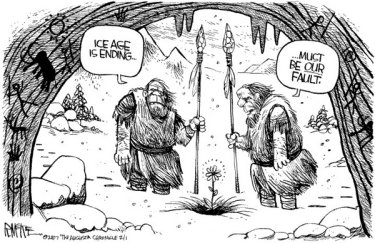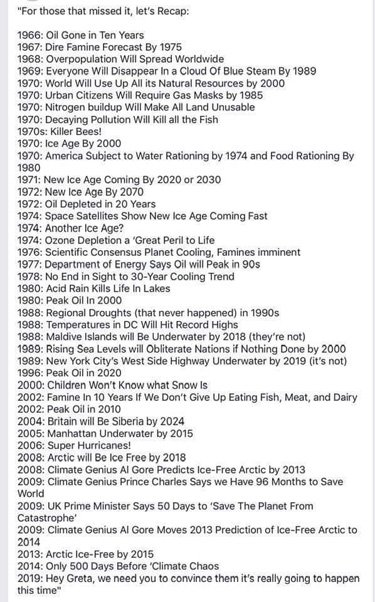Category Archive 'Catastrophism'
01 Sep 2022


Larry Elder compiles a number of important predictions from established science.
“The trouble with almost all environmental problems,’ says Paul R. Ehrlich, the population biologist, ‘is that by the time we have enough evidence to convince people, you’re dead. … We must realize that unless we are extremely lucky, everybody will disappear in a cloud of blue steam in 20 years.’” —The New York Times, 1969.
“No real action has been taken to save the environment, [Ehrlich] maintains. And it does need saving. Ehrlich predicts that the oceans will be as dead as Lake Erie in less than a decade.” —Redlands Daily Facts, 1970. …
“Dear Mr. President: … We feel obliged to inform you on the results of the scientific conference held here recently. … The main conclusion of the meeting was that a global deterioration of climate, by order of magnitude larger than any hitherto experienced by civilized mankind, is a very real possibility and indeed may be due very soon. The cooling has natural cause and falls within the rank of processes which produced the last ice age. … The present rate of the cooling seems fast enough to bring glacial temperatures in about a century.” —Brown University, Department of Geological Sciences, 1972. …
“A senior U.N. environmental official says entire nations could be wiped off the face of the Earth by rising sea levels if the global warming trend is not reversed by the year 2000.” —Associated Press, 1989.
“Unless drastic measures to reduce greenhouse gases are taken within the next 10 years, the world will reach a point of no return.” —former Vice President Al Gore, 2006.
“The world is going to end in 12 years if we don’t address climate change.” —Rep. Alexandria Ocasio-Cortez, D-N.Y., 2019.
09 Nov 2021

HT: Vanderleun.
And there’s no penalty for being wrong. You still get to keep the prizes and awards and your faculty position at some elite university.
Paul Erlich, in 1968, famously warned:
“The battle to feed all of humanity is over. In the 1970s hundreds of millions of people will starve to death in spite of any crash programs embarked upon now. At this late date nothing can prevent a substantial increase in the world death rate.”
Erlich is Bing Professor of Population Studies Emeritus at Stanford University, president of the Center for Conservation Biology at Stanford, and a fellow of the American Association for the Advancement of Science, the United States National Academy of Sciences, the American Academy of Arts and Sciences, and the American Philosophical Society.
You can spout utter and complete horsecrap, but still wind up successful and covered with honors as long as it’s fashionable horsecrap.
29 Oct 2018


There is no limit to the absurd catastrophic alarms generated by the Environmental Religion. They are as many as there are grains of sand on the beach.
Here we have the BBC quoting a German academic telling us that the world may be running out of sand (!).
We extract billions of tonnes of sand and gravel each year to make concrete for the building industry, and this is having an increasing environmental impact as beaches and river beds are stripped, warn campaigners.
Alongside this environmental damage, the building industry is also a major contributor to greenhouse gases – cement manufacturing alone accounts for 7% of global CO2 emissions.
In many countries, sand is often extracted illegally from beaches or river beds. But once sand is taken from a river, the water flow can become faster and more violent – and the water table alongside a river will fall, affecting farming along the river bank.
Dredging beaches for sand increases coastal communities’ vulnerability to storm damage – because sandy beaches act as sponges absorbing a storm’s excess energy – something that is increasingly likely because of climate change.
“The problem is that the demand for sand is outpacing what we know about the environmental impact of extraction,” says Dr Aurora Torres of the German Centre for Integrative Biodiversity Research (iDiv). “It is a hidden ecological disaster.”
RTWT
The article threatening us with running out of stars in the sky is coming next week.
07 Jan 2017

Detail (click on image for whole cartoon)
08 Jul 2010


Matt Ridley points out that predictions of imminent doom have been with us for a long time, in the Huffington Post of all places.
When I was a student, in the 1970s, the world was coming to an end. The adults told me so. They said the population explosion was unstoppable, mass famine was imminent, a cancer epidemic caused by chemicals in the environment was beginning, the Sahara desert was advancing by a mile a year, the ice age was retuning, oil was running out, air pollution was choking us and nuclear winter would finish us off. There did not seem to be much point in planning for the future. I remember a fantasy I had – that I would make my way to the Hebrides, off the west coast of Scotland, and live off the land so I could survive these holocausts at least till the cancer got me.
I am not making this up. By the time I was 21 years old I realized that nobody had ever said anything optimistic to me – in a lecture, a television program or even a conversation in a bar – about the future of the planet and its people, at least not that I could recall. Doom was certain.
The next two decades were just as bad: acid rain was going to devastate forests, the loss of the ozone layer was going to fry us, gender-bending chemicals were going to decimate sperm counts, swine flu, bird flu and Ebola virus were going to wipe us all out. In 1992, the United Nations Earth Summit in Rio de Janeiro opened its agenda for the twenty-first century with the words `Humanity stands at a defining moment in history. We are confronted with a perpetuation of disparities between and within nations, a worsening of poverty, hunger, ill health and illiteracy, and the continuing deterioration of the ecosystems on which we depend for our well-being.’
By then I had begun to notice that this terrible future was not all that bad. In fact every single one of the dooms I had been threatened with had proved either false or exaggerated. …
I now see at firsthand how I avoided hearing any good news when I was young. Where are the pressure groups that have an interest in telling the good news? They do not exist. By contrast, the behemoths of bad news, such as Greenpeace, Friends of the Earth and WWF, spend hundreds of millions of dollars a year and doom is their best fund-raiser. Where is the news media’s interest in checking out how pessimists’ predictions panned out before? There is none. By my count, Lester Brown has now predicted a turning point in the rise of agricultural yields six times since 1974, and been wrong each time. Paul Ehrlich has been predicting mass starvation and mass cancer for 40 years. He still predicts that `the world is coming to a turning point’.
Ah, that phrase again. I call it turning-point-itis. It’s rarely far from the lips of the prophets of doom. They are convinced that they stand on the hinge of history, the inflexion point where the roller coaster starts to go downhill. But then I began looking back to see what pessimists said in the past and found the phrase, or an equivalent, being used by in every generation. The cause of their pessimism varied – it was often tinged with eugenics in the early twentieth century, for example – but the certainty that their own generation stood upon the fulcrum of the human story was the same.
I got back to 1830 and still the sentiment was being used. In fact, the poet and historian Thomas Macaulay was already sick of it then: `We cannot absolutely prove that those are in error who tell us that society has reached a turning point, that we have seen our best days. But so said all before us, and with just as much apparent reason.’ He continued: `On what principle is it that, when we see nothing but improvement behind us, we are to expect nothing but deterioration before us.’
02 Jun 2010

Hat tip to Karen l. Myers.
06 Aug 2009
Pay attention, reporters, all the scary stories you need for filling up front page columns on slow news days for years to come are right here.
05 Jan 2009

You won’t need to worry about Global Warming if the Yellowstone Caldera decides to erupt.
London Times:
Hundreds of earthquakes have hit Yellowstone National Park, raising fears of a more powerful volcanic eruption.
The earthquake swarm, the biggest in more than 20 years, is being closely monitored by scientists and emergency authorities.
The series of small quakes included three last Friday which measured stronger than magnitude 3.0. The strongest since this latest swarm of quakes began on December 27 was 3.9.
No damage has yet been reported but scientists say this level of activity – there have been more than 500 tremors in the last week – is highly unusual.
“The earthquake sequence is the most intense in this area for some years,” said the Yellowstone Volcano Observatory. Some of the larger earthquakes have been felt by park employees and guests, according to the observatory.
The swarm is occurring beneath the northern part of Yellowstone Lake in the park. Yellowstone sits on the caldera of an ancient supervolcano and continuing geothermal activity can be seen in the picturesque geysers and steam holes, such as Old Faithful.
About 1,000 to 2,000 tremors a year have been recorded since 2004. …
Professor Robert B. Smith, a geophysicist at the University of Utah and one of the leading experts on earthquake and volcanic activity at Yellowstone, said that the swarm was significant.
“It’s not business as usual,” he said. “This is a large earthquake swarm, and we’ve recorded several hundred. We are paying careful attention. This is an important sequence.”
The last full-scale explosion of the Yellowstone Supervolcano, the Lava Creek eruption which happened approximately 640,000 years ago, ejected about 240 cubic miles of rock and dust into the sky.
Geologists have been closely monitoring the rise and fall of the Yellowstone Plateau as an indication of changes in magma chamber pressure.
The Yellowstone caldera floor has risen recently – almost 3in per year for the past three years – a rate more than three times greater than ever observed since such measurements began in 1923.
From mid-summer 2004 through to mid-summer 2008, the land surface within the caldera moved upwards as much as 8in at the White Lake GPS station. The last major earthquake swarm was in 1985 and lasted three months.
USGS Yellowstone Volcano Observatory site
Map of recent earthquakes
Your are browsing
the Archives of Never Yet Melted in the 'Catastrophism' Category.
/div>

Feeds
|









